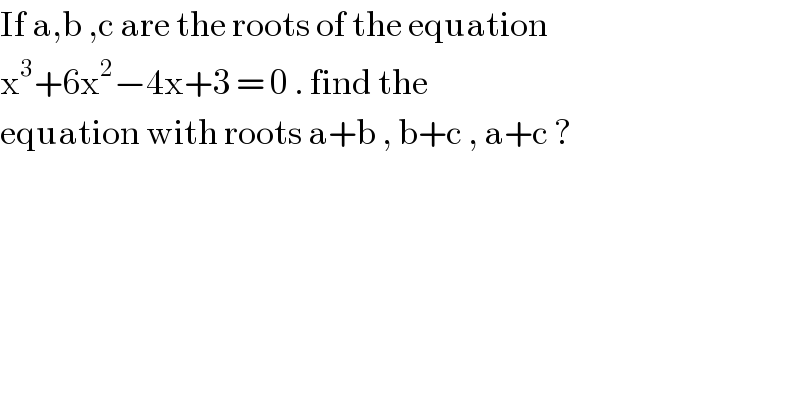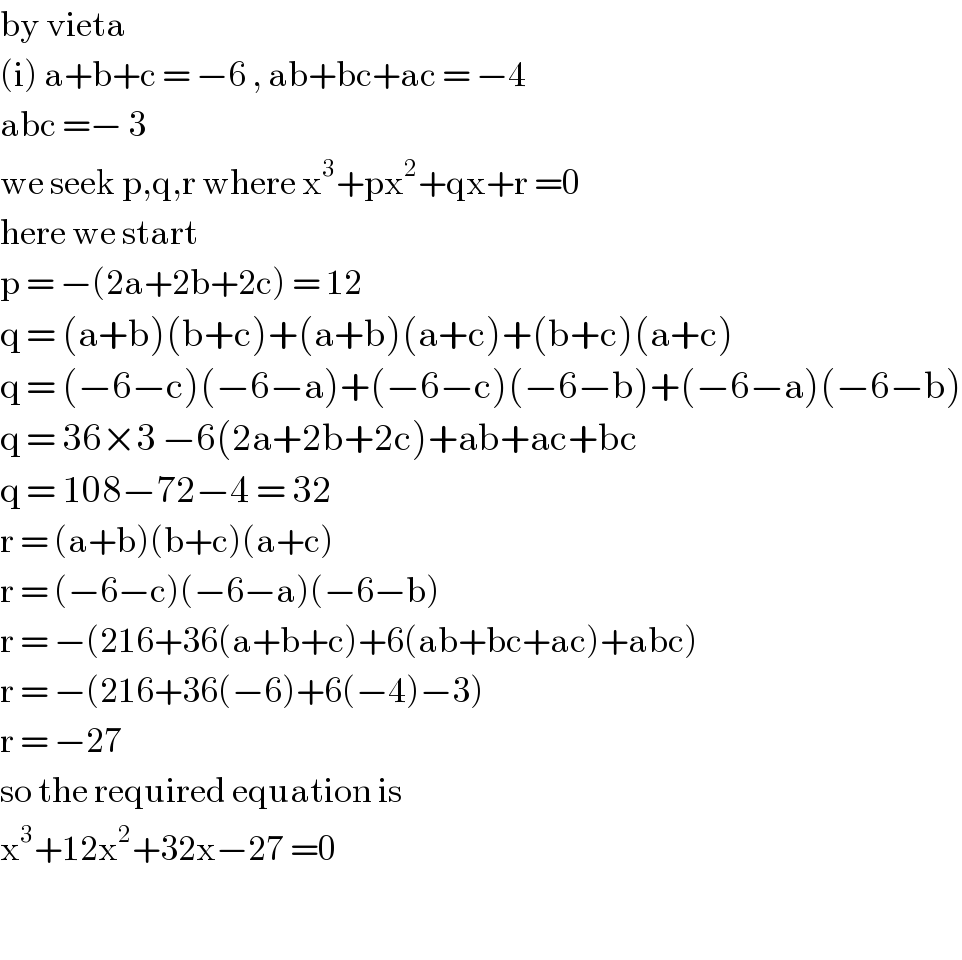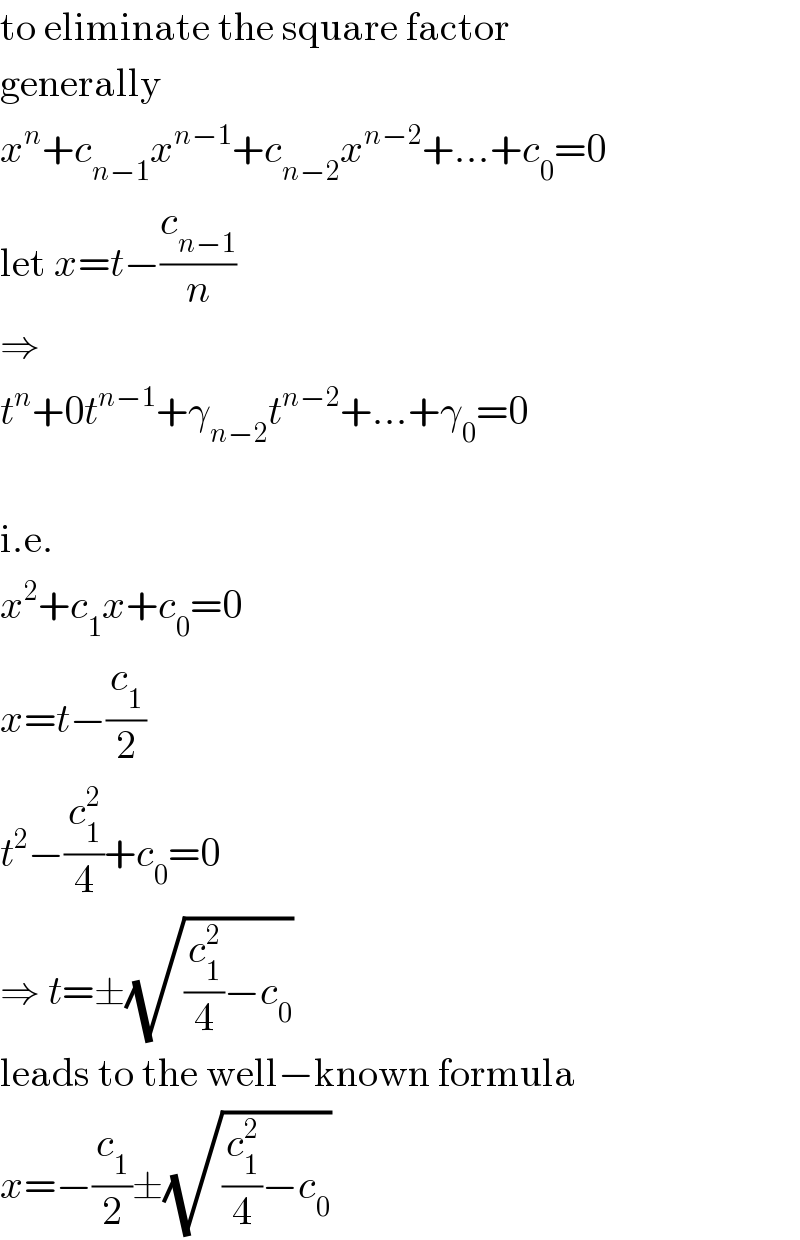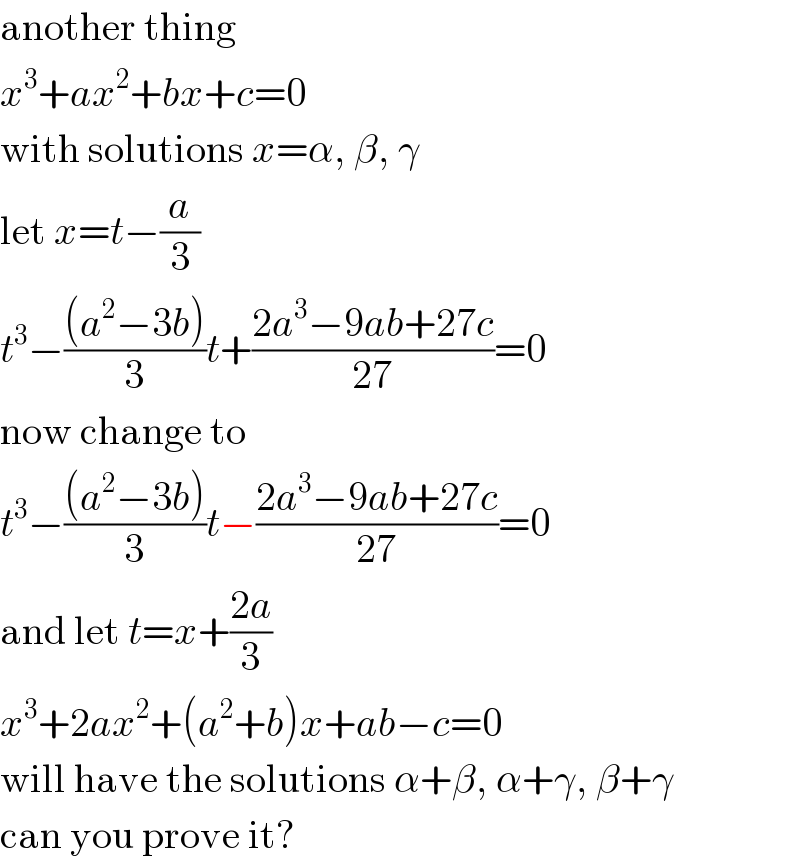
Question Number 86855 by jagoll last updated on 01/Apr/20

$$\mathrm{If}\:\mathrm{a},\mathrm{b}\:,\mathrm{c}\:\mathrm{are}\:\mathrm{the}\:\mathrm{roots}\:\mathrm{of}\:\mathrm{the}\:\mathrm{equation} \\ $$$$\mathrm{x}^{\mathrm{3}} +\mathrm{6x}^{\mathrm{2}} −\mathrm{4x}+\mathrm{3}\:=\:\mathrm{0}\:.\:\mathrm{find}\:\mathrm{the}\: \\ $$$$\mathrm{equation}\:\mathrm{with}\:\mathrm{roots}\:\mathrm{a}+\mathrm{b}\:,\:\mathrm{b}+\mathrm{c}\:,\:\mathrm{a}+\mathrm{c}\:? \\ $$
Answered by john santu last updated on 01/Apr/20

$$\mathrm{by}\:\mathrm{vieta}\: \\ $$$$\left(\mathrm{i}\right)\:\mathrm{a}+\mathrm{b}+\mathrm{c}\:=\:−\mathrm{6}\:,\:\mathrm{ab}+\mathrm{bc}+\mathrm{ac}\:=\:−\mathrm{4} \\ $$$$\mathrm{abc}\:=−\:\mathrm{3} \\ $$$$\mathrm{we}\:\mathrm{seek}\:\mathrm{p},\mathrm{q},\mathrm{r}\:\mathrm{where}\:\mathrm{x}^{\mathrm{3}} +\mathrm{px}^{\mathrm{2}} +\mathrm{qx}+\mathrm{r}\:=\mathrm{0} \\ $$$$\mathrm{here}\:\mathrm{we}\:\mathrm{start} \\ $$$$\mathrm{p}\:=\:−\left(\mathrm{2a}+\mathrm{2b}+\mathrm{2c}\right)\:=\:\mathrm{12} \\ $$$$\mathrm{q}\:=\:\left(\mathrm{a}+\mathrm{b}\right)\left(\mathrm{b}+\mathrm{c}\right)+\left(\mathrm{a}+\mathrm{b}\right)\left(\mathrm{a}+\mathrm{c}\right)+\left(\mathrm{b}+\mathrm{c}\right)\left(\mathrm{a}+\mathrm{c}\right) \\ $$$$\mathrm{q}\:=\:\left(−\mathrm{6}−\mathrm{c}\right)\left(−\mathrm{6}−\mathrm{a}\right)+\left(−\mathrm{6}−\mathrm{c}\right)\left(−\mathrm{6}−\mathrm{b}\right)+\left(−\mathrm{6}−\mathrm{a}\right)\left(−\mathrm{6}−\mathrm{b}\right) \\ $$$$\mathrm{q}\:=\:\mathrm{36}×\mathrm{3}\:−\mathrm{6}\left(\mathrm{2a}+\mathrm{2b}+\mathrm{2c}\right)+\mathrm{ab}+\mathrm{ac}+\mathrm{bc} \\ $$$$\mathrm{q}\:=\:\mathrm{108}−\mathrm{72}−\mathrm{4}\:=\:\mathrm{32} \\ $$$$\mathrm{r}\:=\:\left(\mathrm{a}+\mathrm{b}\right)\left(\mathrm{b}+\mathrm{c}\right)\left(\mathrm{a}+\mathrm{c}\right)\: \\ $$$$\mathrm{r}\:=\:\left(−\mathrm{6}−\mathrm{c}\right)\left(−\mathrm{6}−\mathrm{a}\right)\left(−\mathrm{6}−\mathrm{b}\right) \\ $$$$\mathrm{r}\:=\:−\left(\mathrm{216}+\mathrm{36}\left(\mathrm{a}+\mathrm{b}+\mathrm{c}\right)+\mathrm{6}\left(\mathrm{ab}+\mathrm{bc}+\mathrm{ac}\right)+\mathrm{abc}\right) \\ $$$$\mathrm{r}\:=\:−\left(\mathrm{216}+\mathrm{36}\left(−\mathrm{6}\right)+\mathrm{6}\left(−\mathrm{4}\right)−\mathrm{3}\right) \\ $$$$\mathrm{r}\:=\:−\mathrm{27} \\ $$$$\mathrm{so}\:\mathrm{the}\:\mathrm{required}\:\mathrm{equation}\:\mathrm{is}\: \\ $$$$\mathrm{x}^{\mathrm{3}} +\mathrm{12x}^{\mathrm{2}} +\mathrm{32x}−\mathrm{27}\:=\mathrm{0}\: \\ $$$$ \\ $$
Commented by MJS last updated on 01/Apr/20

$$\mathrm{it}\:\mathrm{must}\:\mathrm{be} \\ $$$${x}^{\mathrm{3}} +\mathrm{12}{x}^{\mathrm{2}} +\mathrm{32}{x}−\mathrm{27}=\mathrm{0} \\ $$
Commented by john santu last updated on 01/Apr/20

$$\mathrm{yes}\:\mathrm{sir}.\:\mathrm{i}\:\mathrm{mistake}\:\mathrm{calculate} \\ $$
Commented by john santu last updated on 01/Apr/20

$$\mathrm{why}\:\mathrm{x}\:=\:\mathrm{t}\:−\:\frac{\mathrm{a}}{\mathrm{3}}\:? \\ $$
Commented by jagoll last updated on 01/Apr/20

$$\mathrm{it}\:\mathrm{is}\:\mathrm{cardano}\:\mathrm{method}\:\mathrm{sir} \\ $$
Commented by MJS last updated on 01/Apr/20

$$\mathrm{to}\:\mathrm{eliminate}\:\mathrm{the}\:\mathrm{square}\:\mathrm{factor} \\ $$$$\mathrm{generally} \\ $$$${x}^{{n}} +{c}_{{n}−\mathrm{1}} {x}^{{n}−\mathrm{1}} +{c}_{{n}−\mathrm{2}} {x}^{{n}−\mathrm{2}} +...+{c}_{\mathrm{0}} =\mathrm{0} \\ $$$$\mathrm{let}\:{x}={t}−\frac{{c}_{{n}−\mathrm{1}} }{{n}} \\ $$$$\Rightarrow \\ $$$${t}^{{n}} +\mathrm{0}{t}^{{n}−\mathrm{1}} +\gamma_{{n}−\mathrm{2}} {t}^{{n}−\mathrm{2}} +...+\gamma_{\mathrm{0}} =\mathrm{0} \\ $$$$ \\ $$$$\mathrm{i}.\mathrm{e}. \\ $$$${x}^{\mathrm{2}} +{c}_{\mathrm{1}} {x}+{c}_{\mathrm{0}} =\mathrm{0} \\ $$$${x}={t}−\frac{{c}_{\mathrm{1}} }{\mathrm{2}} \\ $$$${t}^{\mathrm{2}} −\frac{{c}_{\mathrm{1}} ^{\mathrm{2}} }{\mathrm{4}}+{c}_{\mathrm{0}} =\mathrm{0} \\ $$$$\Rightarrow\:{t}=\pm\sqrt{\frac{{c}_{\mathrm{1}} ^{\mathrm{2}} }{\mathrm{4}}−{c}_{\mathrm{0}} } \\ $$$$\mathrm{leads}\:\mathrm{to}\:\mathrm{the}\:\mathrm{well}−\mathrm{known}\:\mathrm{formula} \\ $$$${x}=−\frac{{c}_{\mathrm{1}} }{\mathrm{2}}\pm\sqrt{\frac{{c}_{\mathrm{1}} ^{\mathrm{2}} }{\mathrm{4}}−{c}_{\mathrm{0}} } \\ $$
Commented by MJS last updated on 01/Apr/20

$$\mathrm{another}\:\mathrm{thing} \\ $$$${x}^{\mathrm{3}} +{ax}^{\mathrm{2}} +{bx}+{c}=\mathrm{0} \\ $$$$\mathrm{with}\:\mathrm{solutions}\:{x}=\alpha,\:\beta,\:\gamma \\ $$$$\mathrm{let}\:{x}={t}−\frac{{a}}{\mathrm{3}} \\ $$$${t}^{\mathrm{3}} −\frac{\left({a}^{\mathrm{2}} −\mathrm{3}{b}\right)}{\mathrm{3}}{t}+\frac{\mathrm{2}{a}^{\mathrm{3}} −\mathrm{9}{ab}+\mathrm{27}{c}}{\mathrm{27}}=\mathrm{0} \\ $$$$\mathrm{now}\:\mathrm{change}\:\mathrm{to} \\ $$$${t}^{\mathrm{3}} −\frac{\left({a}^{\mathrm{2}} −\mathrm{3}{b}\right)}{\mathrm{3}}{t}−\frac{\mathrm{2}{a}^{\mathrm{3}} −\mathrm{9}{ab}+\mathrm{27}{c}}{\mathrm{27}}=\mathrm{0} \\ $$$$\mathrm{and}\:\mathrm{let}\:{t}={x}+\frac{\mathrm{2}{a}}{\mathrm{3}} \\ $$$${x}^{\mathrm{3}} +\mathrm{2}{ax}^{\mathrm{2}} +\left({a}^{\mathrm{2}} +{b}\right){x}+{ab}−{c}=\mathrm{0} \\ $$$$\mathrm{will}\:\mathrm{have}\:\mathrm{the}\:\mathrm{solutions}\:\alpha+\beta,\:\alpha+\gamma,\:\beta+\gamma \\ $$$$\mathrm{can}\:\mathrm{you}\:\mathrm{prove}\:\mathrm{it}? \\ $$
Commented by john santu last updated on 01/Apr/20

$$\mathrm{waw}....\mathrm{super}\:\mathrm{sir}\: \\ $$
